Investment Appraisal Techniques and Financial Ratios Analysis for Jessica Ltd
VerifiedAdded on 2023/06/14
|10
|2422
|93
AI Summary
This report discusses investment appraisal techniques for analysing the suitability of the project in which the company Jessica Ltd is going to invest. Financial ratios of the organisation Omega Ltd. are calculated to evaluate the performance of the company. Non-financial factors are explained which can be used to access the performance of the corporation. The pricing strategy of the organisation Tesco is also discussed.
Contribute Materials
Your contribution can guide someone’s learning journey. Share your
documents today.

top16534 3005
Secure Best Marks with AI Grader
Need help grading? Try our AI Grader for instant feedback on your assignments.
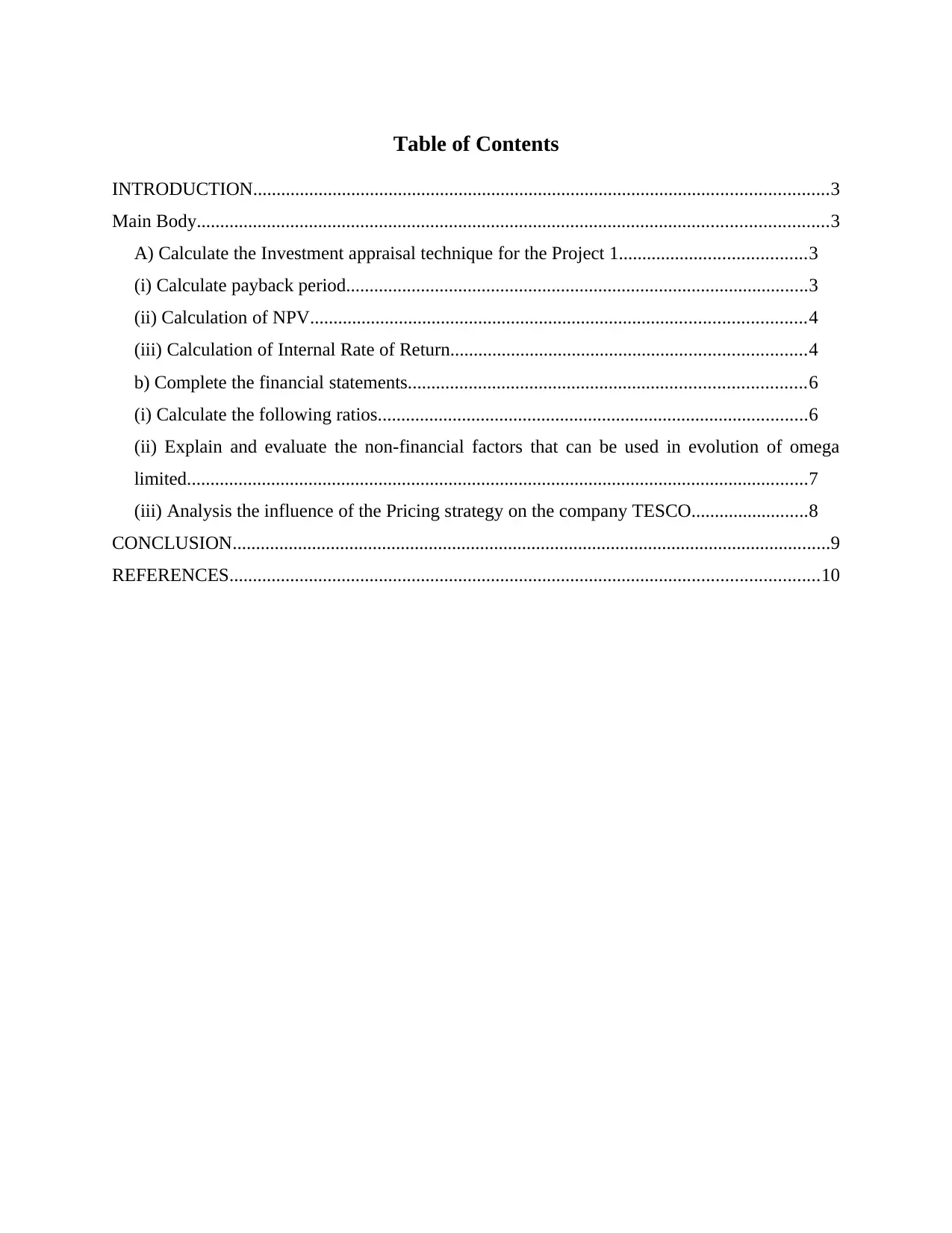
Table of Contents
INTRODUCTION...........................................................................................................................3
Main Body.......................................................................................................................................3
A) Calculate the Investment appraisal technique for the Project 1........................................3
(i) Calculate payback period...................................................................................................3
(ii) Calculation of NPV..........................................................................................................4
(iii) Calculation of Internal Rate of Return............................................................................4
b) Complete the financial statements.....................................................................................6
(i) Calculate the following ratios............................................................................................6
(ii) Explain and evaluate the non-financial factors that can be used in evolution of omega
limited.....................................................................................................................................7
(iii) Analysis the influence of the Pricing strategy on the company TESCO.........................8
CONCLUSION................................................................................................................................9
REFERENCES..............................................................................................................................10
INTRODUCTION...........................................................................................................................3
Main Body.......................................................................................................................................3
A) Calculate the Investment appraisal technique for the Project 1........................................3
(i) Calculate payback period...................................................................................................3
(ii) Calculation of NPV..........................................................................................................4
(iii) Calculation of Internal Rate of Return............................................................................4
b) Complete the financial statements.....................................................................................6
(i) Calculate the following ratios............................................................................................6
(ii) Explain and evaluate the non-financial factors that can be used in evolution of omega
limited.....................................................................................................................................7
(iii) Analysis the influence of the Pricing strategy on the company TESCO.........................8
CONCLUSION................................................................................................................................9
REFERENCES..............................................................................................................................10
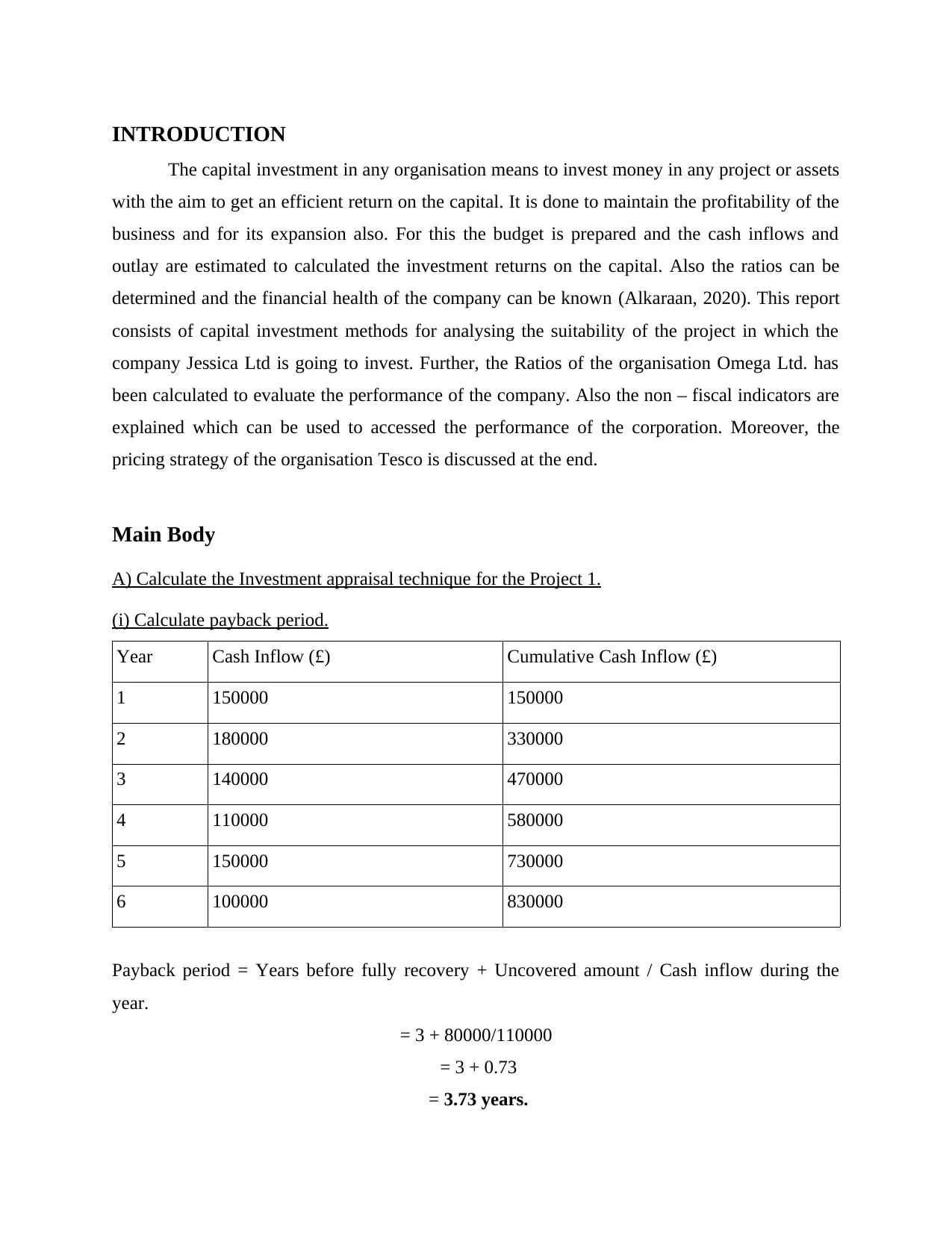
INTRODUCTION
The capital investment in any organisation means to invest money in any project or assets
with the aim to get an efficient return on the capital. It is done to maintain the profitability of the
business and for its expansion also. For this the budget is prepared and the cash inflows and
outlay are estimated to calculated the investment returns on the capital. Also the ratios can be
determined and the financial health of the company can be known (Alkaraan, 2020). This report
consists of capital investment methods for analysing the suitability of the project in which the
company Jessica Ltd is going to invest. Further, the Ratios of the organisation Omega Ltd. has
been calculated to evaluate the performance of the company. Also the non – fiscal indicators are
explained which can be used to accessed the performance of the corporation. Moreover, the
pricing strategy of the organisation Tesco is discussed at the end.
Main Body
A) Calculate the Investment appraisal technique for the Project 1.
(i) Calculate payback period.
Year Cash Inflow (£) Cumulative Cash Inflow (£)
1 150000 150000
2 180000 330000
3 140000 470000
4 110000 580000
5 150000 730000
6 100000 830000
Payback period = Years before fully recovery + Uncovered amount / Cash inflow during the
year.
= 3 + 80000/110000
= 3 + 0.73
= 3.73 years.
The capital investment in any organisation means to invest money in any project or assets
with the aim to get an efficient return on the capital. It is done to maintain the profitability of the
business and for its expansion also. For this the budget is prepared and the cash inflows and
outlay are estimated to calculated the investment returns on the capital. Also the ratios can be
determined and the financial health of the company can be known (Alkaraan, 2020). This report
consists of capital investment methods for analysing the suitability of the project in which the
company Jessica Ltd is going to invest. Further, the Ratios of the organisation Omega Ltd. has
been calculated to evaluate the performance of the company. Also the non – fiscal indicators are
explained which can be used to accessed the performance of the corporation. Moreover, the
pricing strategy of the organisation Tesco is discussed at the end.
Main Body
A) Calculate the Investment appraisal technique for the Project 1.
(i) Calculate payback period.
Year Cash Inflow (£) Cumulative Cash Inflow (£)
1 150000 150000
2 180000 330000
3 140000 470000
4 110000 580000
5 150000 730000
6 100000 830000
Payback period = Years before fully recovery + Uncovered amount / Cash inflow during the
year.
= 3 + 80000/110000
= 3 + 0.73
= 3.73 years.
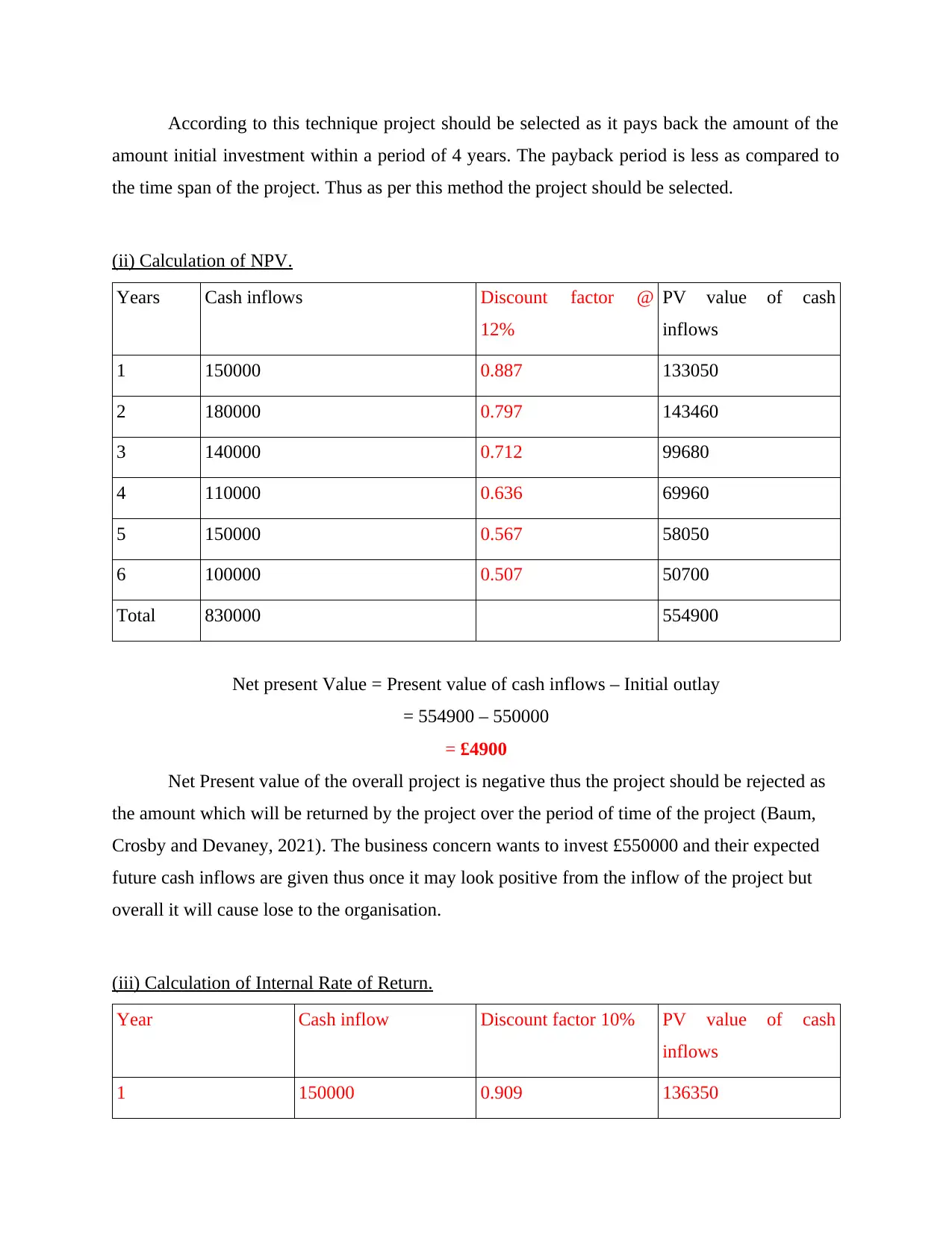
According to this technique project should be selected as it pays back the amount of the
amount initial investment within a period of 4 years. The payback period is less as compared to
the time span of the project. Thus as per this method the project should be selected.
(ii) Calculation of NPV.
Years Cash inflows Discount factor @
12%
PV value of cash
inflows
1 150000 0.887 133050
2 180000 0.797 143460
3 140000 0.712 99680
4 110000 0.636 69960
5 150000 0.567 58050
6 100000 0.507 50700
Total 830000 554900
Net present Value = Present value of cash inflows – Initial outlay
= 554900 – 550000
= £4900
Net Present value of the overall project is negative thus the project should be rejected as
the amount which will be returned by the project over the period of time of the project (Baum,
Crosby and Devaney, 2021). The business concern wants to invest £550000 and their expected
future cash inflows are given thus once it may look positive from the inflow of the project but
overall it will cause lose to the organisation.
(iii) Calculation of Internal Rate of Return.
Year Cash inflow Discount factor 10% PV value of cash
inflows
1 150000 0.909 136350
amount initial investment within a period of 4 years. The payback period is less as compared to
the time span of the project. Thus as per this method the project should be selected.
(ii) Calculation of NPV.
Years Cash inflows Discount factor @
12%
PV value of cash
inflows
1 150000 0.887 133050
2 180000 0.797 143460
3 140000 0.712 99680
4 110000 0.636 69960
5 150000 0.567 58050
6 100000 0.507 50700
Total 830000 554900
Net present Value = Present value of cash inflows – Initial outlay
= 554900 – 550000
= £4900
Net Present value of the overall project is negative thus the project should be rejected as
the amount which will be returned by the project over the period of time of the project (Baum,
Crosby and Devaney, 2021). The business concern wants to invest £550000 and their expected
future cash inflows are given thus once it may look positive from the inflow of the project but
overall it will cause lose to the organisation.
(iii) Calculation of Internal Rate of Return.
Year Cash inflow Discount factor 10% PV value of cash
inflows
1 150000 0.909 136350
Secure Best Marks with AI Grader
Need help grading? Try our AI Grader for instant feedback on your assignments.

2 180000 0.826 148680
3 140000 0.751 105140
4 110000 0.683 75130
5 150000 0.621 93150
6 100000 0.564 56400
Total 830000 614850
Net present Value = Present value of cash inflows – Initial outlay
= 614850 – 550000
= 64850
IRR = LR + (NPVl / NPVl + NPVh) * (HR-LR)
=10% + (64850/ 64850 + 4900) * (12-10)
= 10 % + (64850 / 69750) * 2
= 10 % + (0.93) * 2
= 10 % + 1.86
= 11.86 %
Internal rate of return is a technique which considers the time value of money and is
calculated while considering discounted factors. In the following case two discounting factors
are calculated that are 10% and 12 % respectively. NPV= IRR = 0, it implies that a project which
has the IRR or NPV equals to zero or more than that should be considered. From which
Discounting factor of 12% states that the NPV of the above project is negative while discounting
factor of 10% states that it has a positive cash inflow. Higher the IRR the higher will be the
returns.
Overall from the above calculated techniques it can be concluded that the IRR and
payback period suggests that the project should be selected (Hsiao and Kelly, 2018). Investors
check the profitability of the project before investing in the product. Thus different profitability
aspects of the project are calculated to know the actual profitability of the task. The basic
requirement of any project is that how much the project will give in return of the amount
invested.
3 140000 0.751 105140
4 110000 0.683 75130
5 150000 0.621 93150
6 100000 0.564 56400
Total 830000 614850
Net present Value = Present value of cash inflows – Initial outlay
= 614850 – 550000
= 64850
IRR = LR + (NPVl / NPVl + NPVh) * (HR-LR)
=10% + (64850/ 64850 + 4900) * (12-10)
= 10 % + (64850 / 69750) * 2
= 10 % + (0.93) * 2
= 10 % + 1.86
= 11.86 %
Internal rate of return is a technique which considers the time value of money and is
calculated while considering discounted factors. In the following case two discounting factors
are calculated that are 10% and 12 % respectively. NPV= IRR = 0, it implies that a project which
has the IRR or NPV equals to zero or more than that should be considered. From which
Discounting factor of 12% states that the NPV of the above project is negative while discounting
factor of 10% states that it has a positive cash inflow. Higher the IRR the higher will be the
returns.
Overall from the above calculated techniques it can be concluded that the IRR and
payback period suggests that the project should be selected (Hsiao and Kelly, 2018). Investors
check the profitability of the project before investing in the product. Thus different profitability
aspects of the project are calculated to know the actual profitability of the task. The basic
requirement of any project is that how much the project will give in return of the amount
invested.

b) Complete the financial statements.
(i) Calculate the following ratios.
Current ratio= Current assets/ Current liabilities
= 111000 / 49000
= 2.27:1
Quick ratio = Quick assets / current liabilities
= (111000 - 60000) / 49000
=50000/49000
= 1.02:1
Debt Equity ratio = Debt / Equity
= 400000 / 352000
= 1.14:1
Interest Cover Ratio = EBIT / Interest expenses
= 215000 / 4000
= 53.75 Times
Stock Turnover Ratio = Cost of goods sold / Average inventory
= 500000 / 60000
= 8.33 Times
Debtor's Turnover Ratio = Net Credit sales/ Average account receivable
= 800000 / 30000
= 26.67 Times
Creditors Turnover Ratio = Net Credit purchases / Average payable
= 500000 /14000
= 35.71 Times
Net Profit Ratio = Net profit / Sales*100
= (189900 / 800000) *100
= 23.74 %
Above calculated ratios states the current ratio of the organisation is 2.27:1 which means
that the company has the paying capacity of more than twice of its current liabilities. Quick ratio
(i) Calculate the following ratios.
Current ratio= Current assets/ Current liabilities
= 111000 / 49000
= 2.27:1
Quick ratio = Quick assets / current liabilities
= (111000 - 60000) / 49000
=50000/49000
= 1.02:1
Debt Equity ratio = Debt / Equity
= 400000 / 352000
= 1.14:1
Interest Cover Ratio = EBIT / Interest expenses
= 215000 / 4000
= 53.75 Times
Stock Turnover Ratio = Cost of goods sold / Average inventory
= 500000 / 60000
= 8.33 Times
Debtor's Turnover Ratio = Net Credit sales/ Average account receivable
= 800000 / 30000
= 26.67 Times
Creditors Turnover Ratio = Net Credit purchases / Average payable
= 500000 /14000
= 35.71 Times
Net Profit Ratio = Net profit / Sales*100
= (189900 / 800000) *100
= 23.74 %
Above calculated ratios states the current ratio of the organisation is 2.27:1 which means
that the company has the paying capacity of more than twice of its current liabilities. Quick ratio
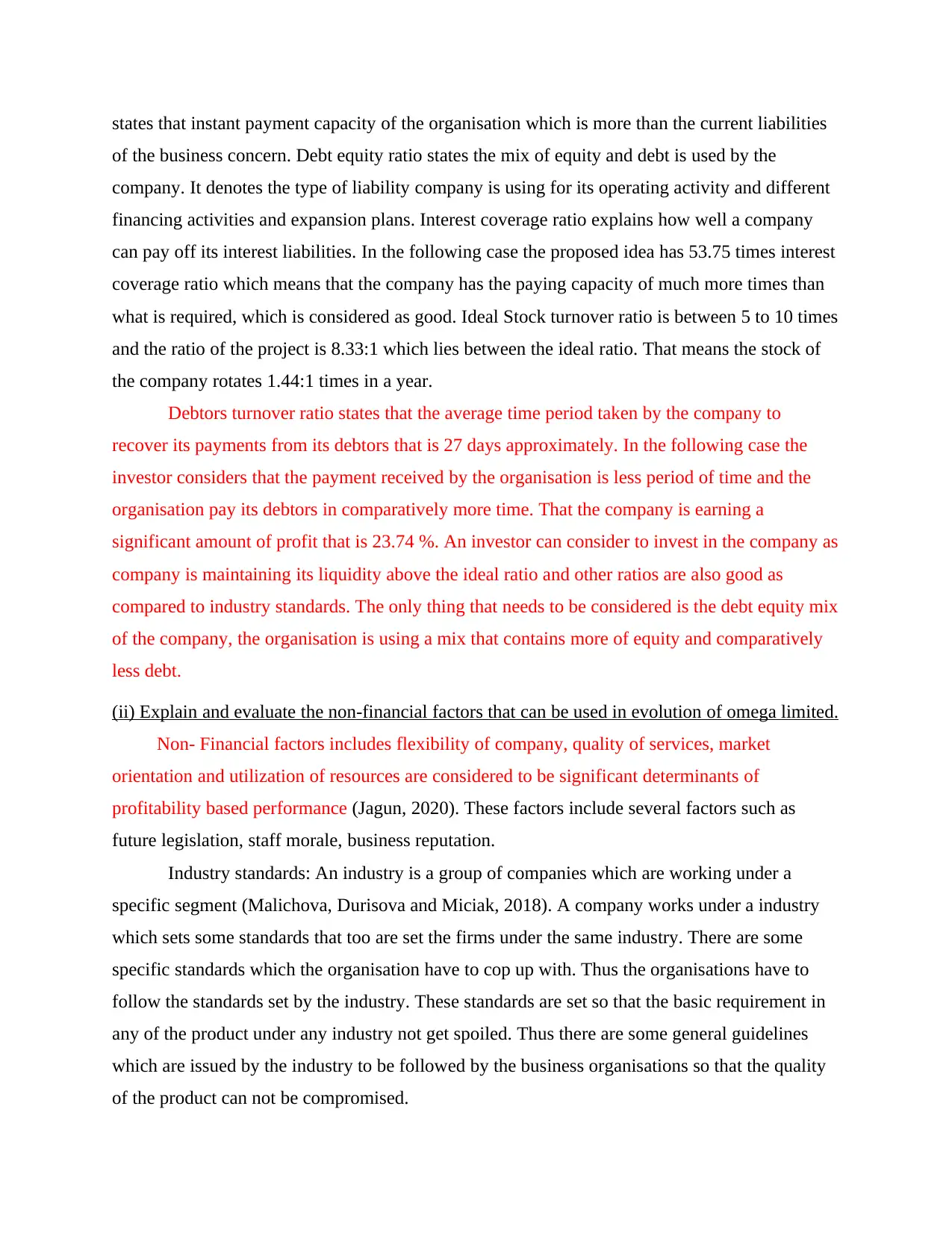
states that instant payment capacity of the organisation which is more than the current liabilities
of the business concern. Debt equity ratio states the mix of equity and debt is used by the
company. It denotes the type of liability company is using for its operating activity and different
financing activities and expansion plans. Interest coverage ratio explains how well a company
can pay off its interest liabilities. In the following case the proposed idea has 53.75 times interest
coverage ratio which means that the company has the paying capacity of much more times than
what is required, which is considered as good. Ideal Stock turnover ratio is between 5 to 10 times
and the ratio of the project is 8.33:1 which lies between the ideal ratio. That means the stock of
the company rotates 1.44:1 times in a year.
Debtors turnover ratio states that the average time period taken by the company to
recover its payments from its debtors that is 27 days approximately. In the following case the
investor considers that the payment received by the organisation is less period of time and the
organisation pay its debtors in comparatively more time. That the company is earning a
significant amount of profit that is 23.74 %. An investor can consider to invest in the company as
company is maintaining its liquidity above the ideal ratio and other ratios are also good as
compared to industry standards. The only thing that needs to be considered is the debt equity mix
of the company, the organisation is using a mix that contains more of equity and comparatively
less debt.
(ii) Explain and evaluate the non-financial factors that can be used in evolution of omega limited.
Non- Financial factors includes flexibility of company, quality of services, market
orientation and utilization of resources are considered to be significant determinants of
profitability based performance (Jagun, 2020). These factors include several factors such as
future legislation, staff morale, business reputation.
Industry standards: An industry is a group of companies which are working under a
specific segment (Malichova, Durisova and Miciak, 2018). A company works under a industry
which sets some standards that too are set the firms under the same industry. There are some
specific standards which the organisation have to cop up with. Thus the organisations have to
follow the standards set by the industry. These standards are set so that the basic requirement in
any of the product under any industry not get spoiled. Thus there are some general guidelines
which are issued by the industry to be followed by the business organisations so that the quality
of the product can not be compromised.
of the business concern. Debt equity ratio states the mix of equity and debt is used by the
company. It denotes the type of liability company is using for its operating activity and different
financing activities and expansion plans. Interest coverage ratio explains how well a company
can pay off its interest liabilities. In the following case the proposed idea has 53.75 times interest
coverage ratio which means that the company has the paying capacity of much more times than
what is required, which is considered as good. Ideal Stock turnover ratio is between 5 to 10 times
and the ratio of the project is 8.33:1 which lies between the ideal ratio. That means the stock of
the company rotates 1.44:1 times in a year.
Debtors turnover ratio states that the average time period taken by the company to
recover its payments from its debtors that is 27 days approximately. In the following case the
investor considers that the payment received by the organisation is less period of time and the
organisation pay its debtors in comparatively more time. That the company is earning a
significant amount of profit that is 23.74 %. An investor can consider to invest in the company as
company is maintaining its liquidity above the ideal ratio and other ratios are also good as
compared to industry standards. The only thing that needs to be considered is the debt equity mix
of the company, the organisation is using a mix that contains more of equity and comparatively
less debt.
(ii) Explain and evaluate the non-financial factors that can be used in evolution of omega limited.
Non- Financial factors includes flexibility of company, quality of services, market
orientation and utilization of resources are considered to be significant determinants of
profitability based performance (Jagun, 2020). These factors include several factors such as
future legislation, staff morale, business reputation.
Industry standards: An industry is a group of companies which are working under a
specific segment (Malichova, Durisova and Miciak, 2018). A company works under a industry
which sets some standards that too are set the firms under the same industry. There are some
specific standards which the organisation have to cop up with. Thus the organisations have to
follow the standards set by the industry. These standards are set so that the basic requirement in
any of the product under any industry not get spoiled. Thus there are some general guidelines
which are issued by the industry to be followed by the business organisations so that the quality
of the product can not be compromised.
Paraphrase This Document
Need a fresh take? Get an instant paraphrase of this document with our AI Paraphraser
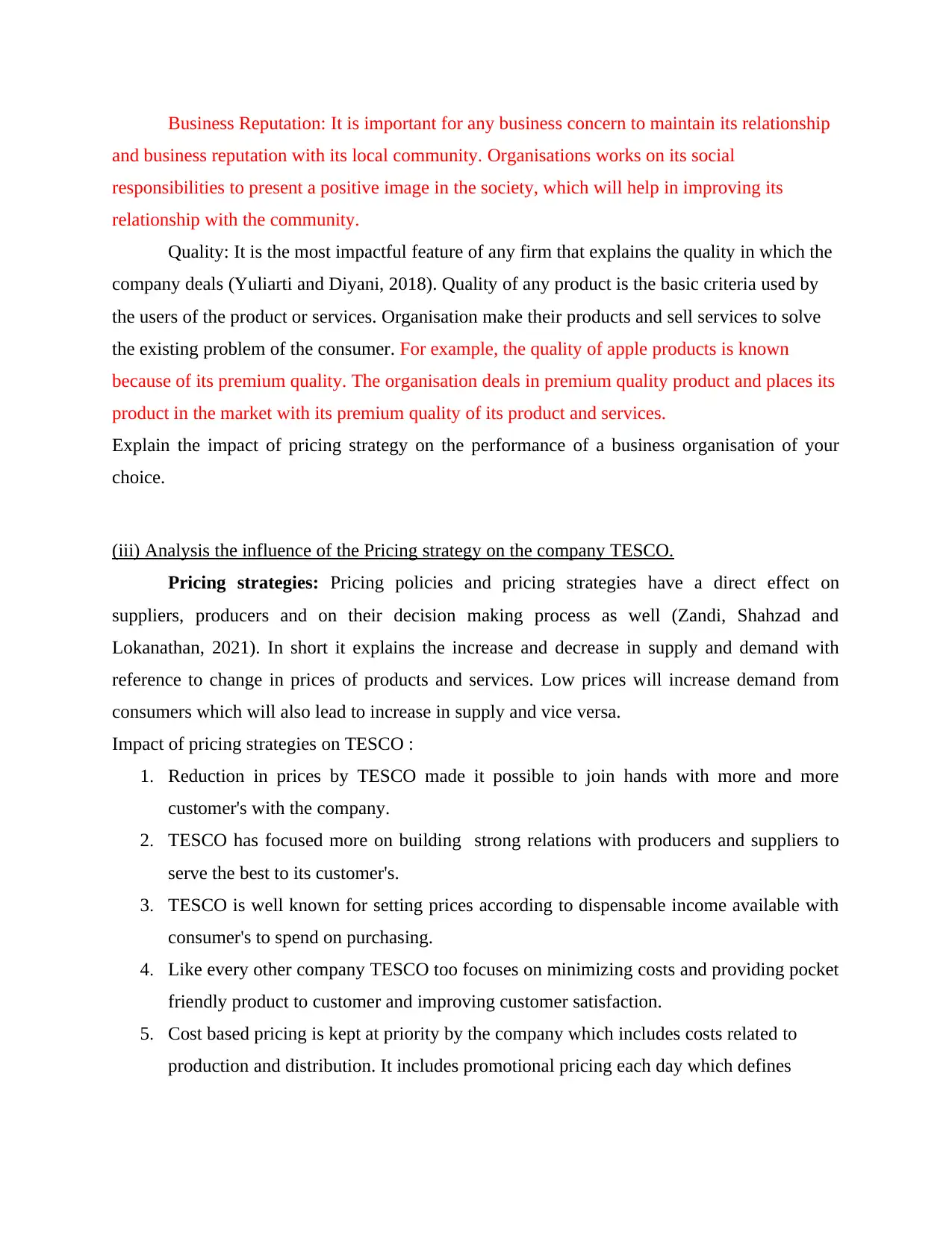
Business Reputation: It is important for any business concern to maintain its relationship
and business reputation with its local community. Organisations works on its social
responsibilities to present a positive image in the society, which will help in improving its
relationship with the community.
Quality: It is the most impactful feature of any firm that explains the quality in which the
company deals (Yuliarti and Diyani, 2018). Quality of any product is the basic criteria used by
the users of the product or services. Organisation make their products and sell services to solve
the existing problem of the consumer. For example, the quality of apple products is known
because of its premium quality. The organisation deals in premium quality product and places its
product in the market with its premium quality of its product and services.
Explain the impact of pricing strategy on the performance of a business organisation of your
choice.
(iii) Analysis the influence of the Pricing strategy on the company TESCO.
Pricing strategies: Pricing policies and pricing strategies have a direct effect on
suppliers, producers and on their decision making process as well (Zandi, Shahzad and
Lokanathan, 2021). In short it explains the increase and decrease in supply and demand with
reference to change in prices of products and services. Low prices will increase demand from
consumers which will also lead to increase in supply and vice versa.
Impact of pricing strategies on TESCO :
1. Reduction in prices by TESCO made it possible to join hands with more and more
customer's with the company.
2. TESCO has focused more on building strong relations with producers and suppliers to
serve the best to its customer's.
3. TESCO is well known for setting prices according to dispensable income available with
consumer's to spend on purchasing.
4. Like every other company TESCO too focuses on minimizing costs and providing pocket
friendly product to customer and improving customer satisfaction.
5. Cost based pricing is kept at priority by the company which includes costs related to
production and distribution. It includes promotional pricing each day which defines
and business reputation with its local community. Organisations works on its social
responsibilities to present a positive image in the society, which will help in improving its
relationship with the community.
Quality: It is the most impactful feature of any firm that explains the quality in which the
company deals (Yuliarti and Diyani, 2018). Quality of any product is the basic criteria used by
the users of the product or services. Organisation make their products and sell services to solve
the existing problem of the consumer. For example, the quality of apple products is known
because of its premium quality. The organisation deals in premium quality product and places its
product in the market with its premium quality of its product and services.
Explain the impact of pricing strategy on the performance of a business organisation of your
choice.
(iii) Analysis the influence of the Pricing strategy on the company TESCO.
Pricing strategies: Pricing policies and pricing strategies have a direct effect on
suppliers, producers and on their decision making process as well (Zandi, Shahzad and
Lokanathan, 2021). In short it explains the increase and decrease in supply and demand with
reference to change in prices of products and services. Low prices will increase demand from
consumers which will also lead to increase in supply and vice versa.
Impact of pricing strategies on TESCO :
1. Reduction in prices by TESCO made it possible to join hands with more and more
customer's with the company.
2. TESCO has focused more on building strong relations with producers and suppliers to
serve the best to its customer's.
3. TESCO is well known for setting prices according to dispensable income available with
consumer's to spend on purchasing.
4. Like every other company TESCO too focuses on minimizing costs and providing pocket
friendly product to customer and improving customer satisfaction.
5. Cost based pricing is kept at priority by the company which includes costs related to
production and distribution. It includes promotional pricing each day which defines
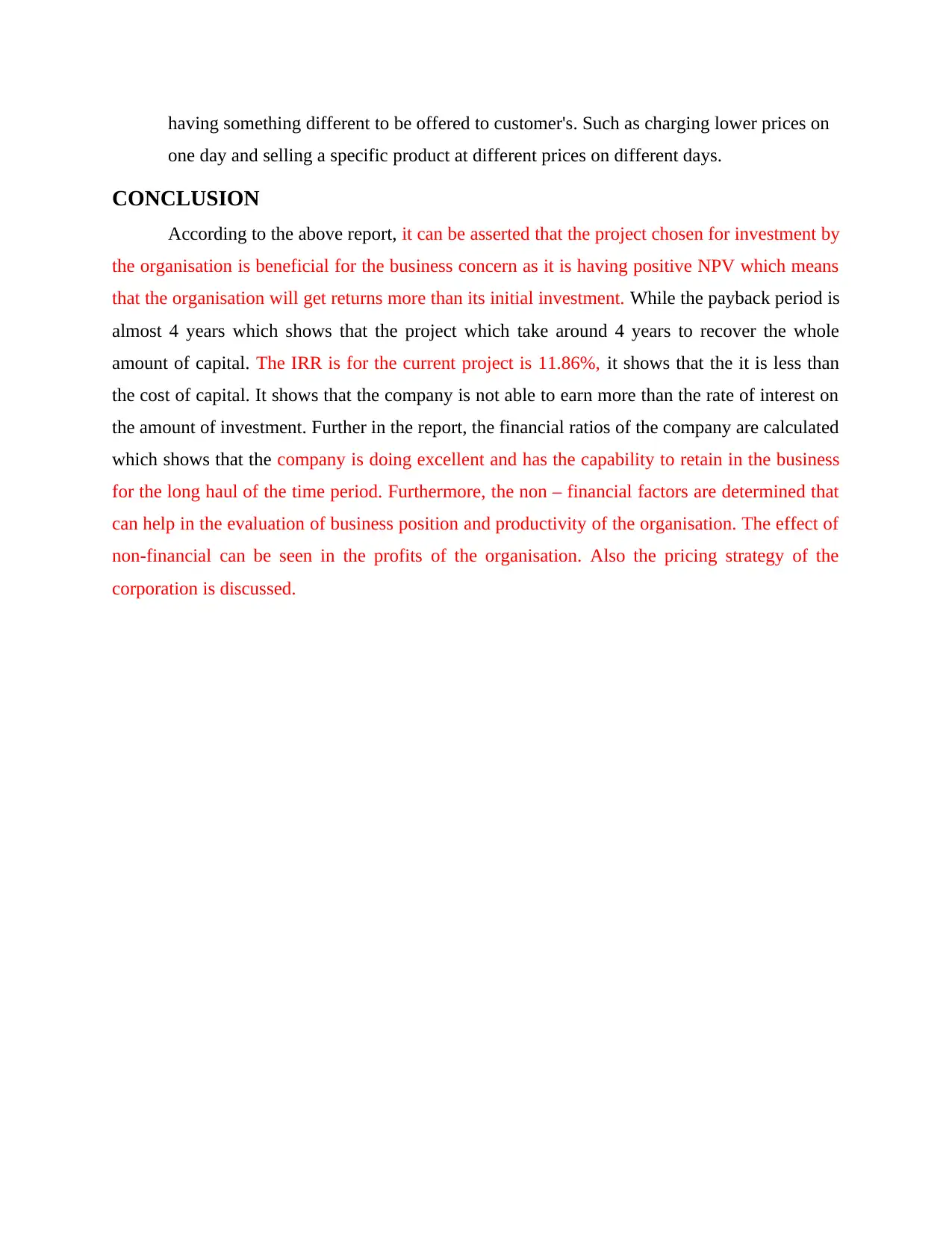
having something different to be offered to customer's. Such as charging lower prices on
one day and selling a specific product at different prices on different days.
CONCLUSION
According to the above report, it can be asserted that the project chosen for investment by
the organisation is beneficial for the business concern as it is having positive NPV which means
that the organisation will get returns more than its initial investment. While the payback period is
almost 4 years which shows that the project which take around 4 years to recover the whole
amount of capital. The IRR is for the current project is 11.86%, it shows that the it is less than
the cost of capital. It shows that the company is not able to earn more than the rate of interest on
the amount of investment. Further in the report, the financial ratios of the company are calculated
which shows that the company is doing excellent and has the capability to retain in the business
for the long haul of the time period. Furthermore, the non – financial factors are determined that
can help in the evaluation of business position and productivity of the organisation. The effect of
non-financial can be seen in the profits of the organisation. Also the pricing strategy of the
corporation is discussed.
one day and selling a specific product at different prices on different days.
CONCLUSION
According to the above report, it can be asserted that the project chosen for investment by
the organisation is beneficial for the business concern as it is having positive NPV which means
that the organisation will get returns more than its initial investment. While the payback period is
almost 4 years which shows that the project which take around 4 years to recover the whole
amount of capital. The IRR is for the current project is 11.86%, it shows that the it is less than
the cost of capital. It shows that the company is not able to earn more than the rate of interest on
the amount of investment. Further in the report, the financial ratios of the company are calculated
which shows that the company is doing excellent and has the capability to retain in the business
for the long haul of the time period. Furthermore, the non – financial factors are determined that
can help in the evaluation of business position and productivity of the organisation. The effect of
non-financial can be seen in the profits of the organisation. Also the pricing strategy of the
corporation is discussed.
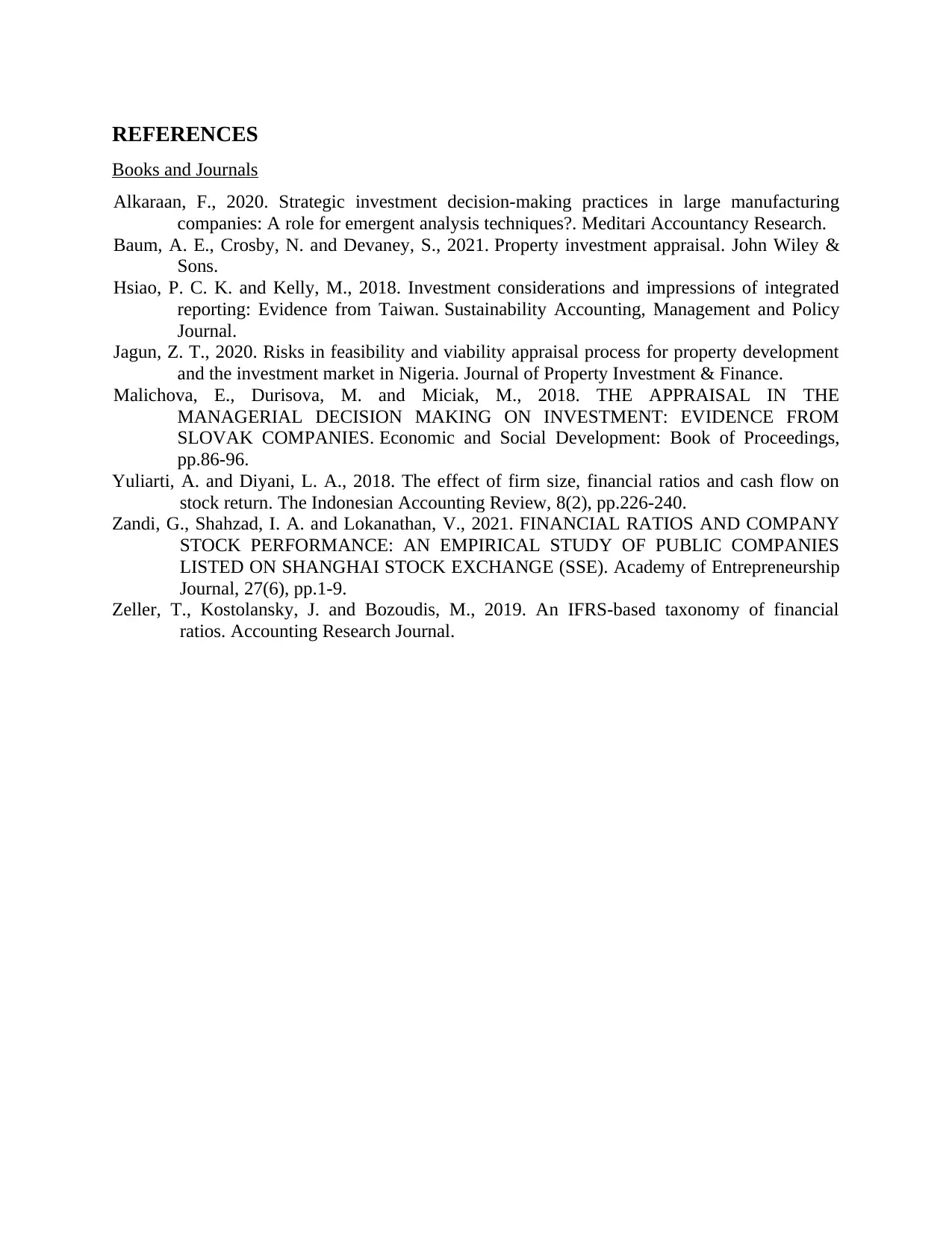
REFERENCES
Books and Journals
Alkaraan, F., 2020. Strategic investment decision-making practices in large manufacturing
companies: A role for emergent analysis techniques?. Meditari Accountancy Research.
Baum, A. E., Crosby, N. and Devaney, S., 2021. Property investment appraisal. John Wiley &
Sons.
Hsiao, P. C. K. and Kelly, M., 2018. Investment considerations and impressions of integrated
reporting: Evidence from Taiwan. Sustainability Accounting, Management and Policy
Journal.
Jagun, Z. T., 2020. Risks in feasibility and viability appraisal process for property development
and the investment market in Nigeria. Journal of Property Investment & Finance.
Malichova, E., Durisova, M. and Miciak, M., 2018. THE APPRAISAL IN THE
MANAGERIAL DECISION MAKING ON INVESTMENT: EVIDENCE FROM
SLOVAK COMPANIES. Economic and Social Development: Book of Proceedings,
pp.86-96.
Yuliarti, A. and Diyani, L. A., 2018. The effect of firm size, financial ratios and cash flow on
stock return. The Indonesian Accounting Review, 8(2), pp.226-240.
Zandi, G., Shahzad, I. A. and Lokanathan, V., 2021. FINANCIAL RATIOS AND COMPANY
STOCK PERFORMANCE: AN EMPIRICAL STUDY OF PUBLIC COMPANIES
LISTED ON SHANGHAI STOCK EXCHANGE (SSE). Academy of Entrepreneurship
Journal, 27(6), pp.1-9.
Zeller, T., Kostolansky, J. and Bozoudis, M., 2019. An IFRS-based taxonomy of financial
ratios. Accounting Research Journal.
Books and Journals
Alkaraan, F., 2020. Strategic investment decision-making practices in large manufacturing
companies: A role for emergent analysis techniques?. Meditari Accountancy Research.
Baum, A. E., Crosby, N. and Devaney, S., 2021. Property investment appraisal. John Wiley &
Sons.
Hsiao, P. C. K. and Kelly, M., 2018. Investment considerations and impressions of integrated
reporting: Evidence from Taiwan. Sustainability Accounting, Management and Policy
Journal.
Jagun, Z. T., 2020. Risks in feasibility and viability appraisal process for property development
and the investment market in Nigeria. Journal of Property Investment & Finance.
Malichova, E., Durisova, M. and Miciak, M., 2018. THE APPRAISAL IN THE
MANAGERIAL DECISION MAKING ON INVESTMENT: EVIDENCE FROM
SLOVAK COMPANIES. Economic and Social Development: Book of Proceedings,
pp.86-96.
Yuliarti, A. and Diyani, L. A., 2018. The effect of firm size, financial ratios and cash flow on
stock return. The Indonesian Accounting Review, 8(2), pp.226-240.
Zandi, G., Shahzad, I. A. and Lokanathan, V., 2021. FINANCIAL RATIOS AND COMPANY
STOCK PERFORMANCE: AN EMPIRICAL STUDY OF PUBLIC COMPANIES
LISTED ON SHANGHAI STOCK EXCHANGE (SSE). Academy of Entrepreneurship
Journal, 27(6), pp.1-9.
Zeller, T., Kostolansky, J. and Bozoudis, M., 2019. An IFRS-based taxonomy of financial
ratios. Accounting Research Journal.
1 out of 10
Related Documents
Your All-in-One AI-Powered Toolkit for Academic Success.
+13062052269
info@desklib.com
Available 24*7 on WhatsApp / Email
![[object Object]](/_next/static/media/star-bottom.7253800d.svg)
Unlock your academic potential
© 2024 | Zucol Services PVT LTD | All rights reserved.




